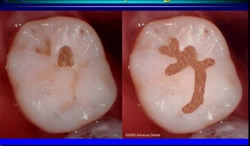Micro-dentistry is a new, alternative way to treat decay in teeth. The idea behind this technology is to remove as little of the natural tooth as possible while removing all of the decay without the need for drilling, and in some cases without the need for an anesthetic. Micro dentistry techniques are used to detect and restore tiny cavities in difficult to find areas.


Cavities on the grooves of the teeth are simple to spot using x-rays and exploration methods. Smaller cavities are harder to detect, and this is where the micro dentistry procedure is required. By detecting the smaller cavities before they grow and penetrate the inner layers, dentists can prevent the need for root canal treatment.

No matter how sophisticated the restorative tool, the same goals are sought as with the first generation of crude instruments: conservative removal of decayed tissues, controlled and minimal removal of sound tooth structure to provide correct resistive and retentive preparation forms, and placement of a durable, bonded restoration. Many of these goals are currently met using today's technology.
However, the use of these instruments still leads to time-consuming and repetitive motions, resulting in long procedures that increase patient cost and minimize the number of patients treated on a daily basis. A prime opportunity exists to apply advanced aerospace technology to dental instruments as a means to improve oral health care delivery.
Directed jet technology is envisioned as the basis for a new unified dental treatment device, providing the dentist with a more efficient approach to routine dental caries treatment. The functions of dental caries removal (cavity preparation), restoration (filling), and preventative treatment application can be performed with a single, unified hand piece based on directed particle-laden jet technology; one tool can be used to perform all of the steps required in routine dental treatment.
The feasibility of the idea is being investigated both numerically (using the commercial FLUENT software) and experimentally. The measurements of the carrier jet flow field, and the trajectories and concentration of the particles are obtained using a modified Stereo Particle Image Velocimetry (PIV) technique. The efficiency of active flow control on the jet, using control jets will be evaluated via controlling the jet's spreading rate, and particles' concentration and trajectories.